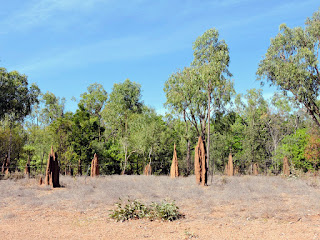(Magyar változat a végén)
 |
| Mango plantation along the Arnhem Highway |
 |
| The thermal pool at the Resort |
 |
| Bitter Springs |
 |
| The palm forest around Bitter Springs |
The area around the pools is a natural breeding ground of the little red flying fox. While they are protected species, they make a lot of damage in the palms, and nuisance to the tourists. At the Resort water sprinklers are installed at the level of the palm tops in an (not too successful) attempt to move them away from the walking tracks.
(We have been here in 2012)
Monday (27 June) morning we continued Southward on the Stuart Highway, then after about 160 kms we turned East on the Carpentaria Highway. This is mostly a one-lane road with very little traffic, going through a very sparsely populated area. If we meet a car in the opposite direction, both cars have to slow down and move aside on the wide gravel shoulder to let the other vehicle pass. Fortunately there is so little traffic, it only happens a few times along the way.
 |
| The Carpentaria Highway |
 |
| Our camp site at Little River |
 |
| The Police Station Museum |
 |
| A painting from the Art Centre |
There is a local art centre showing and offering for sale (for exorbitant prices) a collection of Aboriginal art works.
 |
| The old and new road across the McArthur River |
--------------------
 |
| Újabb termesz-várak |
 |
| Bitter Springs |
Másnap visszamentünk a kicst távolabbi nagyon termál fürdőhöz, amit Bitter Springs-nek (keserű forrás) hívnak. Egy munkás nevezte el így 1871-ben mert a víz valóban kesernyés izű és szagú. A szagát a vízben lévő baktéria okozza, ami a vízben oldott szulfát sókból elvonja az oxigént, és kénhidrogén marad belőle. De valójában nem olyan rossz a szaga és a víz nagyon kellemes. Itt egy pár száz méter hosszú félkörben lehet lebegni a lassú árral a sűrű pálmaerdő közepén, amit többször is megtettünk.
 |
| Pálmaerdő a fürdő körül |
(Jártunk itt 2012-ben is...)
 |
| Az egysávos autóút |
Az uticélunk Borroloola település volt a Carpentaria Öböl közelében, de ez túl messze volt, megálltunk éjszakára egy szabad táborhelyen egy kis patak mellett amit Little Creek-nek hívtak. mint a legtöbb folyóvíz ezen a vidéken, ez sem folyik a száraz évszakban, de itt megmaradt egy elég nagy vízmedence, még néhány vízimadarat is láttunk halászni. Találkoztunk egy Adelaide-i házaspárral akikkel jól elbeszélgettünk vacsora után. Kellemes este volt, jóval hűvösebb mint északabbra és szerencsére mentes minden csípkedő rovaroktól.
Másnap reggel (jun. 28) innen már csak 130 km volt Borroloola-ig. Kb 60 km-el B. előtt hagytuk el a hatalmas McArthur River Bányát, ahol cink-, ólom- és ezüst-kitermelés folyik, amit a Bing Bong nevű kikötőbe szállítanak a Carpentaria Öbölben, 50 km-re Borroloola-tól. Innen kezdve széles kétsávos jó állapotú út vezetett Borroloola-ba.
 |
| Táborhelyünk Borroloola-ban |
 |
| A művészeti központ |
Két éjszakát töltöttünk itt, kicsit vásároltunk, és végigjártuk a "nevezetességeket", amiből nem sok van. A régi rendőrség épülete 1886-ban épült, ma felújítva a városi múzeum, tele mindenféle régi eszközökkel, és információs táblákkal amik bemutatját a város történetét.
 |
| A McArthur folyó a régi gázlóval |
Kicsivel a városon kívül megnéztük a McArthur folyót a régi gázló és az új híd keresztezésénél. Ez az út vezet az ún. Savanah Way-re, egy többszáz km-es földútra Queensland felé. Eredetileg az volt a tervünk, hogy erre megyünk tovább, ezért jöttünk ide. De aztán meggondoltuk magunkat...


Miért gondoltátok meg magatokat? Nehéz? Veszélyes? Lassú? Gyertek az M3 -on az kellemesebb, bár nincs ennyi látnivaló!;) Üdv Pufi
ReplyDeleteMiért gondoltátok meg magatokat? Nehéz? Veszélyes? Lassú? Gyertek az M3 -on az kellemesebb, bár nincs ennyi látnivaló!;) Üdv Pufi
ReplyDelete